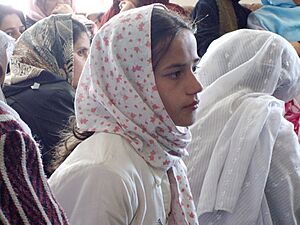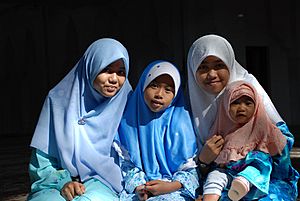Islam and clothing facts for kids
Muslims have different ways of dressing for different situations. Some ideas about hijab mean that people should dress in a simple and respectful way, both when they are outside and when they are taking part in religious activities. The clothes people wear every day, inside and outside their homes, can be different and often depend on their family's traditions.
Clothes for Boys and Men
Muslim men also have certain rules about what they wear. These rules often focus on dressing respectfully.
A man's clothing often includes:
- Dishdasha: This is a long, loose dress or robe.
- Bisht: This is a cloak worn over the dishdasha, often for special occasions.
- Ghutra: This is a scarf worn on the head.
- Taqiyah: This is a small cap worn under the ghutra to help keep it in place.
- Agal: This is a black cord that also helps to hold the ghutra on the head.
Clothes for Girls and Women

Islam teaches that women should dress in a special way. This way of dressing applies to women and teenage girls, but not usually to young children. If you visit some Islamic countries, women are often expected to dress this way too.
At the very least, clothes should cover the shoulders. Long-sleeved tops and trousers are often preferred. Many women also use a headscarf to cover their hair, especially when they go into a mosque or other place of worship.
Here are some common types of clothing:
- Abaya: This is a long, flowing outer garment. It is worn over all other clothes.
- Jilbab: This is a garment that can be worn like a dress. People often wear trousers underneath it.
- Dupatta: This is a long, rectangular scarf. It is usually worn over the shoulders or around the neck. Women sometimes use a dupatta to cover their head as a hijab.
- Hijab: This is the head covering worn by many Muslim women. It is traditionally a square piece of fabric folded into a triangle. It can also be a rectangular shape. To wear it, you bring the two corners together and pin, knot, or wrap it at the neck.
- Niqab: This is a veil worn to cover the face. A niqab can be made to leave only the eyes uncovered. Some styles leave the eyes and forehead uncovered, or even the forehead, eyes, and nose, covering only the mouth.
Images for kids
-
Muslim woman in niqab.
-
Female art students in Afghanistan.
-
Hijab-wearing Bangladeshi women shopping at a department store in Comilla, Bangladesh.
-
Muslim girls at Istiqlal Mosque in Jakarta











